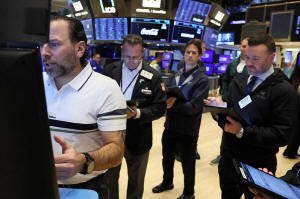Scorching US economy throws off market's Fed cut narrative
 Send a link to a friend
Send a link to a friend
 [February 03, 2024] By
Lewis Krauskopf [February 03, 2024] By
Lewis Krauskopf
NEW YORK (Reuters) - Robust U.S. economic data is confronting investors
with an unexpected question: whether strong growth can keep driving
stocks higher even if the Federal Reserve delivers less monetary-policy
easing than the market had hoped.
Expectations that the Fed would pivot to cutting rates sent stocks
soaring at the end of 2023 and pushed the S&P 500 to a record high in
January. The index is up 4% this year after surging 24% in 2023.
That narrative has been jolted by evidence that the economy may be
running too hot for the Fed to cut rates without risking an inflationary
rebound. Friday's blockbuster U.S. employment number was the latest sign
of stronger-than-expected growth, after Fed Chairman Jerome Powell days
earlier deflated hopes the central bank would begin lowering rates in
March.
"Looking back on the fourth quarter and the recent rally in stocks, a
lot of it was driven from the thought of a Fed pivot, and the Fed pivot
is evaporating in front of our eyes," said Matthew Miskin, co-chief
investment strategist at John Hancock Investment Management.
Market expectations of a near-term rate cut dimmed after the jobs data,
with futures tied to the Fed's main policy rate reflecting a 70% chance
of the central bank lowering borrowing costs at its May 1 meeting, from
over 90% on Thursday, according to the CME FedWatch Tool. The
probability of a March cut stood at about 20%, from just under 50% a
week ago.
With Friday's jobs report, "the six or seven rate cuts that markets had
been pricing in seems very offside," Seema Shah, chief global strategist
at Principal Asset Management, said in a written commentary.

Friday's jobs report showed nonfarm payrolls increased by 353,000 jobs
last month - well above the 180,000 increase expected by economists
polled by Reuters. The economy also added 126,000 more jobs in November
and December than previously reported.
Plenty of investors believe the strong growth is a positive for stocks,
especially if accompanied by better-than-expected corporate earnings.
The S&P 500 hit a fresh high on Friday after the jobs data, helped by
the soaring shares of Facebook parent Meta Platforms and Amazon, which
rose 20% and 8%, respectively, following their corporate results.

[to top of second column] |

Traders work on the floor at the New York Stock Exchange (NYSE) in
New York City, U.S., February 1, 2024. REUTERS/Brendan McDermid/File
Photo

For 2024, S&P 500 earnings are expected to jump nearly 10% after a
3.6% rise in 2023, according to LSEG data. Those expectations will
be tested in the coming week with another heavy batch of reports,
including from Eli Lilly, Walt Disney and ConocoPhillips.
"I'll trade a stronger economy with less rate cuts than a weaker
economy with more rate cuts," said Keith Lerner, co-chief investment
officer at Truist Advisory Services.
Analysts at Capital Economics forecast a "banner" year for U.S.
stocks, finishing 2024 over 10% above current levels at 5,500.
Optimism over the business potential of artificial intelligence,
which helped power stocks such as Nvidia last year, will likely
drive those gains, they said.
However, sustained above trend growth poses another issue - fears of
an inflationary rebound.
"January job growth figures were strong, possibly too strong," said
Russell Price, chief economist at Ameriprise, in a Friday note.
"There were multiple signs of strong wage growth which could filter
through to resurgent ... inflation pressures if maintained."
A longer period of high interest rates also could increase stress
for areas of the economy that are already hurting such as commercial
real estate.
Shares of New York Community Bancorp, a major CRE lender in New
York, have tumbled in recent days, setting off broader regional
banking concerns, after the company slashed its dividend and posted
a surprise loss.
Ramped-up growth, along with expectations of rates staying at
current levels for longer, could drive Treasury yields up. Higher
yields can pressure equities because they compete with stocks for
investors, while higher rates raise the cost of capital in the
economy.
The benchmark 10-year Treasury yield, which moves inversely to bond
prices, hit 4.05% on Friday.
Investors are still pricing in around 125 basis points of Fed cuts
this year, LSEG data shows. That is down from around 150 basis
points priced in earlier this week, but still far more than the 75
basis points the Fed has projected.
(Reporting by Lewis Krauskopf; additional reporting by Chibuike Oguh;
Editing by Ira Iosebashvili and Richard Chang)
[© 2024 Thomson Reuters. All rights
reserved.]
This material may not be published,
broadcast, rewritten or redistributed.
Thompson Reuters is solely responsible for this content. |